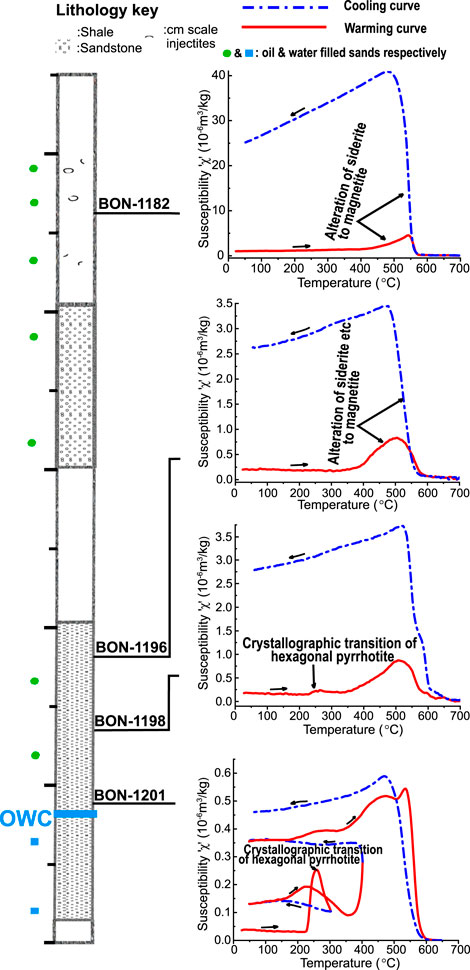
94% of researchers rate our articles as excellent or good
Learn more about the work of our research integrity team to safeguard the quality of each article we publish.
Find out more
ERRATUM article
Front. Earth Sci., 04 January 2023
Sec. Sedimentology, Stratigraphy and Diagenesis
Volume 10 - 2022 | https://doi.org/10.3389/feart.2022.1118266
This article is an erratum on:
High temperature susceptibility measurements: A potential tool for the identification of oil-water transition zone in petroleum reservoirs
by Abdulkarim MA, Muxworthy AR and Fraser A (2022) Front. Earth Sci. 10:973385. doi: 10.3389/feart.2022.973385
Due to a production error, an incorrect version of Figure 5 was included in the published article. The correct version of Figure 5 appears below. The publisher apologizes for this mistake.

FIGURE 5. Example results from the HT-χ measurements carried out on the Bonneville samples. The magnetic minerology of the “main” oil leg is dominated by siderite. The oil-water region presents a diminished siderite signature and the presence of hexagonal pyrrhotite. Note that the oil-water contact (OWC) marked is as obtained via well logs and pressure analysis.
The original version of this article has been updated.
All claims expressed in this article are solely those of the authors and do not necessarily represent those of their affiliated organizations, or those of the publisher, the editors and the reviewers. Any product that may be evaluated in this article, or claim that may be made by its manufacturer, is not guaranteed or endorsed by the publisher.
Keywords: magnetic mineral diagenesis, oil water contact, oil-water transition zone, magnetic method, UK Central North Sea, biodegradation, hydrolysis
Citation: Frontiers Production Office (2023) Erratum: High temperature susceptibility measurements: A potential tool for the identification of oil water transition zone in petroleum reservoirs. Front. Earth Sci. 10:1118266. doi: 10.3389/feart.2022.1118266
Received: 07 December 2022; Accepted: 07 December 2022;
Published: 04 January 2023.
Approved by:
Frontiers Editorial Office, Frontiers Media SA, SwitzerlandCopyright © 2023 Frontiers Production Office. This is an open-access article distributed under the terms of the Creative Commons Attribution License (CC BY). The use, distribution or reproduction in other forums is permitted, provided the original author(s) and the copyright owner(s) are credited and that the original publication in this journal is cited, in accordance with accepted academic practice. No use, distribution or reproduction is permitted which does not comply with these terms.
*Correspondence: Frontiers Production Office, cHJvZHVjdGlvbi5vZmZpY2VAZnJvbnRpZXJzaW4ub3Jn
Disclaimer: All claims expressed in this article are solely those of the authors and do not necessarily represent those of their affiliated organizations, or those of the publisher, the editors and the reviewers. Any product that may be evaluated in this article or claim that may be made by its manufacturer is not guaranteed or endorsed by the publisher.
Research integrity at Frontiers

Learn more about the work of our research integrity team to safeguard the quality of each article we publish.